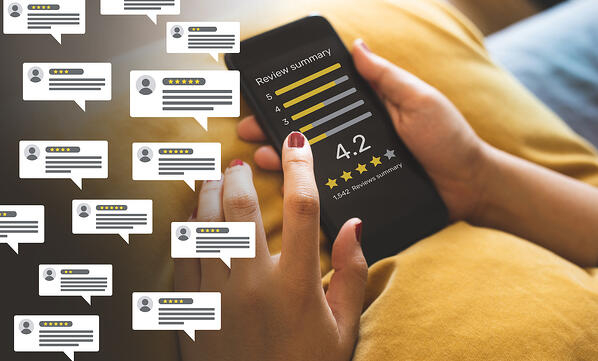
As providers think about moving into a geographic market, they ask themselves, “What is the community’s perception of existing providers of care?” Sifting through conjecture, hearsay and unverified information to reach facts and answer this question is difficult.
Years ago, analyzing public perception went only bar stool deep, with opinions flowing freely from providers and community leaders as to what “everyone knew” about A or B doctor, medical practice or hospital. Later, healthcare consultants and administrators could bring more objective data to the discussion, data points like CMS’ quality ratings, HCAHPS scores, US News and World Reports ranking, and in the case of hospitals, outmigration levels (i.e., how many local patients went elsewhere for care). As new ratings are released, patient volumes can change as much as 5 percent as non-emergent care moves to higher-ranked hospitals.[1] In the case of nursing homes, 1-star facilities typically lost 8 percent of their market share and 5-star facilities gained over 6 percent of their market share as soon as CMS publicly announced its nursing homes ratings.[2] So, these ratings do give important insight that should be considered. However, these scores are more often what healthcare elites focus on rather than the general public. Those healthcare providers and administrators are important stakeholders for staffing recruitment, but they aren’t gatekeepers for care anymore.

The digitization of healthcare has caused patients to use online platforms such as Google or Yelp, tools that they rely on when buying other services, to judge and choose where they receive care.[3]. There are four things that matter most to patients when choosing their care: accessibility when it comes to urgent care, reputation when it comes to long-term care, cost, and above all else, online ratings from consumer websites.[4] Three out of four Americans say that they use online patient reviews as the first step in choosing a new provider[5], and 90% say they consider online reviews before deciding.[6]
Since there is a mismatch in what executives and patients use to evaluate healthcare options, there is a large risk of leaders arriving at the wrong answer. This risk is magnified by the increased posting of fake reviews, which is a growing problem as review fraud grows globally. There are few incentives to eliminate fake reviews and a lack of disciplinary action related to them, so they often remain on these sites unchecked for consumers to read.[7] Even if a hospital has received poor quality ratings and HCAHPS scores, patients are still likely to choose the site if they see positive reviews from other patients, fabricated or not.
This is clearly a public policy issue since the proper functioning of the healthcare market is often paid for by taxes. The implications of misinformation are far different than say, the restaurant industry or an Amazon product with fake reviews. However, we want to focus on what providers can do to (1) understand where they really stand relative to competitors, and (2) drive patients towards valid reviews of care.
1. Leverage a consulting firm (like Array Advisors) to directly ask the community.
A more proactive approach that will lead to the most accurate and timely information possible is to conduct your own study (not of your patients but a sampling of the entire community), which could take one of two forms:
- Survey: utilizing new, cloud-based crowdsourcing technology capabilities can give a real-time look at perceptions of specific players in the market from a targeted audience. This is most useful in markets where you are trying to gauge broad perceptions and in metro areas of scale. These tools have a hard time capturing the right sample in a small town. However, the cost of this service is not significant, just as the web has lowered the barriers to entry for national retail, web-based tools have lowered the barrier to gathering public opinion in a community.
- Sentiment analysis: utilizing big data analytics and technology, social media text can be scraped and analyzed to identify the general population’s attitudes about healthcare options from the opinions expressed in the text. While similar to leveraging existing review sites, this method extracts information from sources that individuals post to much more often than specific review sites. This can give a lot of nuance and reach into smaller metro areas quite effectively, but it is more expensive than the web-based outreach. Such methods would allow providers to have their fingers on the pulse of public’s perception of their facility since they provide real-time analysis of web data.
2. Leveraging Trusted Review Sites:
 While an imperfect analysis, some review sites, like CareDash, have committed themselves to providing transparent and trustworthy information about healthcare providers, practices, and hospitals. CareDash compiles verified patient reviews, detailed patient experience scores, pharmaceutical payments, and disciplinary action reports to give a holistic picture of a provider or facility.[8] While a good cursory option, this is a passive method of analysis, relying on existing reviews that may be limited by quantity and recency (especially if competitors do not have a strong online reputation management strategy).
While an imperfect analysis, some review sites, like CareDash, have committed themselves to providing transparent and trustworthy information about healthcare providers, practices, and hospitals. CareDash compiles verified patient reviews, detailed patient experience scores, pharmaceutical payments, and disciplinary action reports to give a holistic picture of a provider or facility.[8] While a good cursory option, this is a passive method of analysis, relying on existing reviews that may be limited by quantity and recency (especially if competitors do not have a strong online reputation management strategy).
As the healthcare environment and consumer behavior changes, the way healthcare leaders evaluate markets must be adjusted or risk incomplete assessments that could lead to costly, inaccurate decisions. While it adds an additional step and another factor to consider, investing in these types of analyses will give a timely, holistic view of perception and performance that will best inform capital project decision-making. At Array Advisors, we are happy to provide these services to customers seeking to bridge the existing knowledge gap.
Sources
[1] https://review.chicagobooth.edu/public-policy/2020/article/hospital-ratings-are-deeply-flawed-can-they-be-fixed
[2] https://onlinelibrary.wiley.com/doi/full/10.1111/1475-6773.12459
[3] https://www.forbes.com/sites/reenitadas/2019/12/04/top-8-predictions-that-will-disrupt-healthcare-in-2020/?sh=11553d157f1e
[4] https://www.onyxmd.com/about-onyx-md/blog/4-major-factors-patients-use-when-choosing-a-healthcare-provider/
[5] https://www.patientpop.com/blog/running-a-practice/internet-new-ways-patients-find-physicians/
[6] https://www.softwareadvice.com/resources/how-patients-use-online-reviews/
[7] https://www.washingtonpost.com/business/2021/06/04/fake-medical-reviews-google-zocdoc-trustpilot/
[8] https://www.caredash.com/


